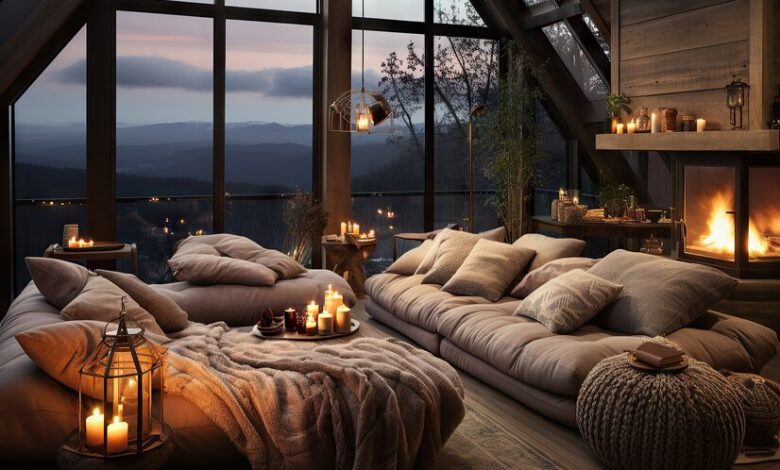Warmth in the Woods: How to Keep Your Mountain Home Cozy This Winter

Winter in the mountains can be magical, but it brings unique challenges for homeowners. The picturesque snow-capped views come with freezing temperatures, making it essential to maintain a warm and cozy indoor environment. Achieving this without skyrocketing energy bills or compromising the environment is a common concern among mountain homeowners and eco-conscious families. This guide aims to provide practical insights and sustainable solutions for keeping your mountain home warm throughout the winter.
Understanding Your Home’s Heating Needs
Mountain homes have different heating requirements compared to homes in lower altitudes. Factors like altitude, insulation quality, and the size of your home play significant roles in determining your heating needs. At higher altitudes, the air is thinner, which can make heating more challenging and energy-intensive.
Conducting an energy audit can help identify areas of heat loss and inefficiencies. An energy audit typically involves a professional assessment of your home’s insulation, windows, doors, and heating systems. It highlights where improvements can be made to enhance energy efficiency and reduce heating costs.
Sustainable Heating Solutions
Eco-friendly heating options are crucial for reducing your carbon footprint and ensuring long-term sustainability. Here are some sustainable heating solutions suitable for mountain homes:
- Geothermal Heat Pumps:
- Utilize the stable, underground temperatures to heat your home.
- Highly efficient, reducing both energy costs and environmental impact.
- Wood Pellet Stoves:
- Use compressed wood or biomass pellets, which are renewable and produce less pollution.
- Provide a cozy, rustic heating solution.
- Solar Heating:
- Incorporate solar panels to harness the sun’s energy.
- Supplement existing heating systems, reducing reliance on fossil fuels.
Optimizing your existing heating system for efficiency is another way to ensure comfort without excessive energy consumption. Regular maintenance, such as cleaning filters and servicing furnaces, is essential for optimal performance.
Winterizing Practices
Preparing your mountain home for winter involves several winterization practices to prevent heat loss and protect your property from the elements.
- Sealing Drafts:
- Use weatherstripping and caulk to seal gaps around windows and doors.
- Install draft stoppers at the base of doors to keep cold air out.
- Insulating Pipes:
- Wrap pipes with insulation to prevent freezing and bursting.
- Consider adding insulation to attics, basements, and crawl spaces to maintain consistent indoor temperatures.
- Outdoor Protection:
- Cover outdoor furniture and equipment to protect them from snow and ice.
- Clear gutters and downspouts to prevent ice dams and water damage.
The Role of Furnishings and Decor
Interior design and furniture placement can significantly impact the warmth and comfort of your mountain home. Here are some strategic tips:

- Rugs and Carpets:
- Place rugs and carpets on hardwood or tile floors to add insulation and reduce heat loss.
- Opt for thick, plush materials for maximum warmth.
- Heavy Curtains:
- Use heavy, insulated curtains to trap heat inside and block cold drafts.
- Close curtains at night and open them during the day to maximize natural heat from the sun.
- Cozy Decor:
- Incorporate winter-themed decor like fleece throws, knitted blankets, and plush cushions.
- Arrange furniture to create intimate, warm spaces, such as placing sofas near the fireplace.
Community Insights
Learning from the experiences of other mountain homeowners can provide valuable insights into effective heating and winterizing practices. Here are some real-life experiences and advice:
- John and Maria’s Story:
- “We installed a geothermal heat pump last year, and it has made a world of difference. Our home stays warm, and our energy bills have decreased significantly.”
- Expert Opinion:
- Local expert, Karen Mitchell, recommends, “Investing in proper insulation and regular maintenance of heating systems is key to ensuring efficiency and comfort during winter.”
- Community Tips:
- “Don’t underestimate the power of rugs and heavy curtains. We noticed a huge difference in warmth after adding them to our home,” says a member of the Mountain Homeowners Association.
Conclusion
Keeping your mountain home cozy and warm in winter is achievable with the right strategies and sustainable practices. By understanding your home’s heating needs, exploring eco-friendly heating solutions, implementing winterization practices, and leveraging the power of interior design, you can create a comfortable and energy-efficient living space.
Remember, adopting sustainable living practices not only benefits the environment but also enhances your overall well-being. For more tips and community engagement, [insert call-to-action here]. Stay warm and enjoy the beauty of winter in your mountain home!



